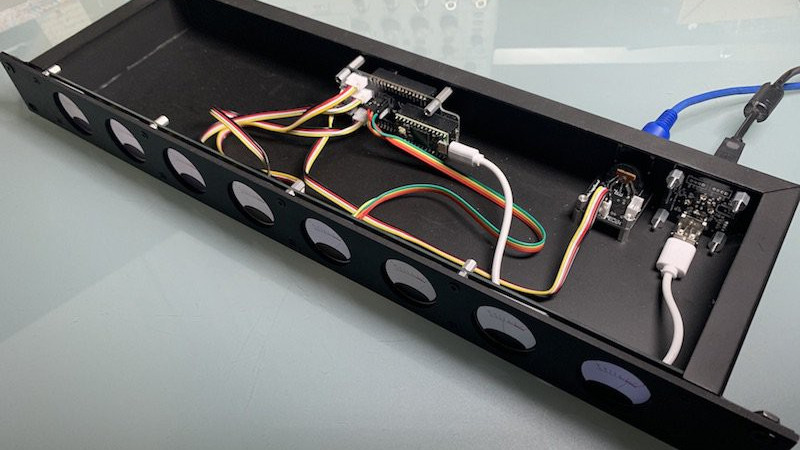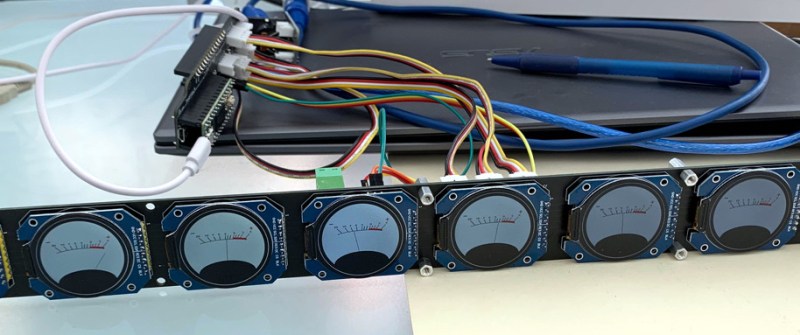Like many of you, we’re intrigued by the possibilities offered by the availability of affordable round LCD panels. But beyond the smartwatches they were designed for, it’s not always easy to come up with an appropriate application for such non-traditional displays. Digital “steam gauges” are one of the first ideas that come to mind, so it’s perhaps no surprise that’s the direction [Tom Dowad] took his project. But rather than just one or two gauges, he decided to go all out and put eight of them in a 1U rack mountable unit.
What do you need eight faux-analog gauges for? Beats us, but that’s not our department. Now [Tom] has a whole row of indicators that can be used to show whatever it is he likes to keep an eye on. The fact that the device is actually controlled via MIDI may provide us a clue that there’s a musical component at play (no pun intended), but then, it wouldn’t be the first time we’d seen MIDI used simply as a convenient and well supported way of synchronizing gadgets.
Beyond the eight 240 x 240 pixel panels, the unit features a Teensy 4.0, some level shifters, and a 74HC138 which is used to select which display the microcontroller is to communicate with. On the software side he’s using the Arduino environment with some PNG decompression routines lifted from [Larry Bank] and graphics code from [moononournation]. The background image of the gauge is apparently a licensed stock photo, which might seem a bit extravagant, but we can’t deny the final result looks very realistic.
Just last year we covered a primer on working with round LCDs, and we’ve already seen some enterprising hackers using them in custom smartwatches. Whether you’re suffering from aichmophobia, or just sick of being limited to the same boring displays in your gadgets, it’s exciting to see the community embracing this new technology.

















Would be helpful for an at-a-glance rack health monitor. Display max service uptime, rack ambient temp, CPU temp, RAM util, network util and CPU util for all the machines in the rack (would need fiddling depending on composition of rack ofc). Thought, really, max over the last couple days would be most useful for servers. Takes up what could be considered too much space at 1U, but again that’d depend on the user.
These days that is all on your phone. And you can set up alerts if anything gets the slightest bit wonky.
yeah but that’s not Fun
The slightest? Yeah, cry wolf yourself out of noticing a major problem why not.
Old analogue meters that were intended to be rack mounted had a round’ish expansion of the needle shape / width below the scale so you could see an approximation from a distance and decide if you need to go have a closer look – to see it more accurately.
If that’s what you really want, instead of round dials and a sweep needle, take a page from more modern aircraft.
Linear veritcal guages. Each with a scale appropriate to what they’re displaying. Middle of the range is the green/good area. There can be a yellow and red, abover or below the green as appropriate. The displayed level can be a height bar, or even better – a very visible dot/dash/___ across at its value.
Just scan down the line of guages, if something isn’t lined up with the others, it’s not at its normal value, requiring a second look for which range it’s in, and beyon that, go over and read the actual value (or click on that same info reported in a window on your box). Heirachy: scan, look, read.
That image at the top of the article … made me think of googly eyes!
So how about an entire-row-of-servers monitor: when it detects an error the eyes will swivel to
look at the offending server :-)
An Admin can diagnose with just a glance ;-)
But it may creep out people who dislikes multiple eyes looking around at one offending meter with funky reading.
Lasers, it needs lasers
This is a perfect example of Skeuomorph, maybe add some black crinkle paint, chrome plated toggle switches, bakelite knobs, and white uppercase labeling for that real 1940s look. Of course you should use it to monitor the output from your solar panels for the ironic effect.
These would make perfect mini power indicators for the Krell.
My thought exactly!!!
I came here to say just that.
Some of Leslie Nielsen’s finest work.
Retro analogue tiny line with all the info etc. but the exposed terminals are waiting for a wintertime static shock. Why reinvent wobbly wheels and exposed circuits “enclosures’?
Retro looking replacement for uninspiring modern car instrument screen?
Very little information provided on the hackaday.io page. No code, no BOM, nothing. Thanks for sharing!
Kind of missing pinball dynamics to put Demon’s Tilt back in the realm of living room accessories with no PC tells. You know, flames firing ‘behind’ the glass when the meter’s pegged, crossed pupils when the data is nonsense, curved arrangements which may or may not vary, all the BioShock bells and whistles…
Would be awesome for a home powerball!
*Powerwall*. Dang autocorrect
I see those 18650 power walls. They should be called back yard power walls or garage power walls, home power walls is too scary.
So Tim, what happened to your house? – Oh, about 295kW.
That’s probably what that Oak Island pit was… failsafe for a high density power bank… it’s probably still smoldering when they finally get to the bottom.
Given the edge of each LCD is hidden by the front panel cut-out, and they are in a rectangular case, what is the actual advantage of using the round LCDs here?
The Krill lab in Forbidden Planet needed a lot of them.
Something strikes me on the picture. The display itself is round, but the pcb behind it is square.
What do we gain from having a more expensive display with some pixels removed, if in the end it is still a square?
Wouldn’t it have been cheaper/simpler to have a square LCD or any rectangular one, and simply add a 3d printed round bezel in front of it?
Not a jab at the project, but the product used seems a bit non sensical.
I have seen round displays that were actually round. There was one that a guy integrated into a pringles can, with it filling almost all the diameter with screen rather than bezels.
I WANT THOSE.
In the tab right next to this one I have an image of a DCS;World helicopter cockpit. Simulation players routinely recreate the cockpits in real life equipment; while switches and indicators are pretty easy to do, dial instruments are notoriously hard to recreate. Of course, physical dials are much nicer, but this seems to be a reasonable compromise. The issue I see is the cockpit I am looking at right now has FIFTEEN of those…
As for roundness: it seems there are models of those which have a round PCB… But yes, bezelling a rectangular one might still be more sensible.